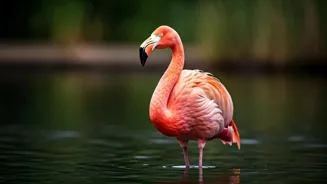Flamingo's Fabulous Pink
Flamingos, with their iconic pink feathers, are a sight to behold. Their coloration stems from the pigments found in the algae and crustaceans they consume.
These long-legged birds inhabit tropical and subtropical wetlands across the globe. They are social creatures, often gathering in large flocks, and they use their specialized beaks to filter food from the water. Their diet, rich in carotenoids, gives their feathers that signature pink hue. The intensity of the color can vary depending on the flamingo's diet and health, making it a fascinating indicator of their well-being. Observing flamingos offers a vibrant glimpse into the ecological interconnectedness of wetlands and their inhabitants.
Rosy Pink River Dolphins
The Amazon river dolphin, often called the pink river dolphin, is a remarkable freshwater mammal native to the Amazon and Orinoco river systems. Unlike their ocean-dwelling cousins, these dolphins boast a unique pink coloration that varies from light rose to deep magenta. The color intensifies with age and excitement. The dolphins use echolocation to navigate and hunt in the murky waters of the Amazon. They are intelligent and social creatures, interacting with each other and playing a vital role in their ecosystem. Their unique appearance and behavior make them a symbol of the biodiversity of the Amazon rainforest. The pink river dolphins are a marvel of adaptation and a reminder of the planet's biological richness.
Pink Roseate Spoonbills
The Roseate Spoonbill stands out with its vibrant pink plumage, which it acquires from its diet, similar to flamingos. They have a distinctive spoon-shaped bill used to sift through mud and shallow water to find food. These birds are found in wetlands and coastal areas of the Americas, and they thrive in environments rich in crustaceans and other invertebrates. Their pink coloration, coupled with their unique bills, makes them easily recognizable. They are social birds, often nesting in colonies. Conservation efforts focus on protecting their wetland habitats to ensure they have access to food and breeding grounds. They represent the delicate balance of ecosystems and the importance of preserving biodiversity.
Axolotl's Pink Glow
The axolotl, a unique amphibian native to the lake systems of Mexico, is known for its regenerative abilities and striking appearance. While they come in various colors, including pink or even albino, they are often displayed in vivid pink hues. These amphibians retain their larval features throughout their adult lives, a process known as neoteny. Their feathery gills add to their unique appearance. The axolotl's ability to regenerate limbs, spinal cords, and even parts of their brain is a focus of scientific research. Their vulnerability in their native habitat highlights the need for conservation efforts to protect their genetic potential. They are an example of nature's resilience and the importance of scientific exploration.
Pink Sea Star Wonders
Sea stars, also known as starfish, are fascinating marine invertebrates found in oceans worldwide. Some species, such as the Pink Sea Star, exhibit vibrant pink colors, adding beauty to the ocean floor. These colors can serve as camouflage or warning signals. They have the ability to regenerate limbs and play a vital role in their ecosystems by controlling populations of other marine life. Their varied forms and adaptations show the diversity of marine life. Their presence highlights the delicate balance within underwater environments. They represent the incredible diversity and beauty of the marine world, urging appreciation and protection of these ecosystems.
Pink Katydid's Camouflage
Katydids, belonging to the insect family Tettigoniidae, often camouflage themselves among foliage. However, some exhibit the rare and captivating pink coloration. This pink coloration, though less common, can be an example of genetic variation or a disruption in their typical camouflage. The pink katydids might stand out more to predators, but they still showcase the amazing range of colors in nature. They use their antennae to sense their surroundings and their camouflage serves as a survival mechanism. These insects also play an essential role in the food chain and maintain the balance of their ecosystems. They underscore the wonder of insect diversity.
Pink Orchid Mantis
The Orchid Mantis is a unique and beautiful insect that camouflages itself to resemble a flower, and in some cases, they appear in pink hues. The color helps the insect to blend in with orchid flowers. These insects are ambush predators, lying in wait for unsuspecting insects. Their appearance not only serves as a camouflage but also as a method to attract prey. The orchid mantis is an example of nature's creativity, perfectly blending beauty and function. They serve as a reminder of the intricate relationships within ecosystems. Their existence encourages further study of insect evolution.
Pink Fairy Armadillo's Magic
The Pink Fairy Armadillo, the smallest species of armadillo, is an elusive creature native to the grasslands of Argentina. This small mammal gets its name from its pink shell and delicate appearance. They have a unique lifestyle, spending most of their time underground. The pink color, combined with their small size, makes them a fascinating species. They use their strong claws to dig burrows. Their shy nature makes them difficult to study, but conservation efforts focus on protecting their fragile habitat. The Pink Fairy Armadillo serves as a symbol of the biodiversity of the grasslands. These animals remind everyone about the significance of safeguarding the natural world.
Pink Cockatoo's Charm
The Galah, also known as the Pink Cockatoo, is a vibrant and social bird found in Australia. Their appearance is striking, with pink plumage on their chest and belly, contrasted by grey wings and back. They're known for their playful nature and their ability to adapt to various habitats. They form strong bonds and are often seen in pairs or large flocks. Their calls and social behaviors have captivated birdwatchers. Protecting their habitats is critical for their survival. They demonstrate the natural beauty of Australia's wildlife. The Galah underscores the importance of understanding and conserving these iconic species.
Pink Slug's Surprise
The Strawberry Slug, found in the mountains of California, is a striking example of nature's artistry. This terrestrial gastropod has a vibrant pink to red body with a light-colored mantle, resembling a strawberry. These slugs eat fungi and decaying matter, playing an important role in nutrient cycling. Their bright color may serve as a warning to predators. They inhabit a specific and vulnerable ecological niche. Their presence reveals the importance of preserving their habitat, particularly the old-growth forests where they live. The Strawberry Slug is a symbol of the surprising biodiversity of the natural world.



